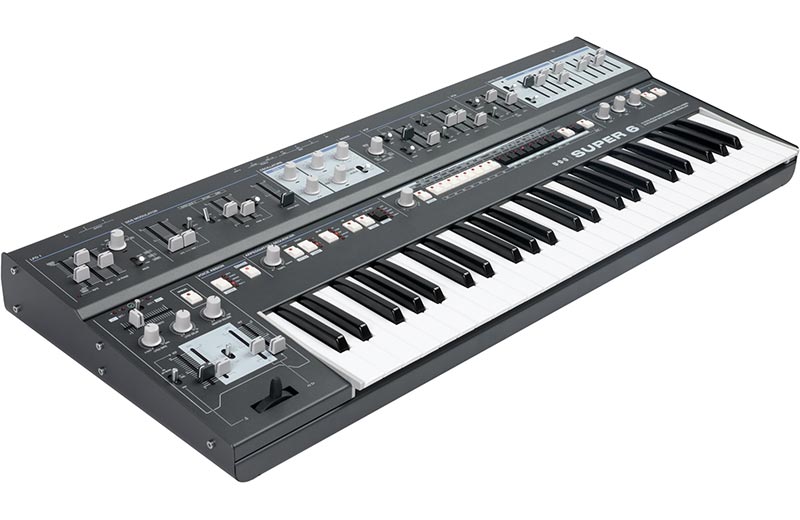UDO Audio is now shipping their Super 6, which they claim is a new take on the traditional analog synthesizer as a 12 Voice polyphone binaural analog-hybrid synth with something called “Super Wave” technology baked in. Super 6 claims to feature unique sound design functionalities, featuring FPGA (Field-Programmable Gate Array) digital hardware oscillators coupled with analog filters and amplifiers.

FPGA digital hardware oscillators are coupled with analog filters and amplifiers, while its unique super-wavetable core can be shaped and manipulated with the binaural analog signal path and flexible modulation. Perfectly paired with a focus on build quality and mechanical design duly benefitting from the design expertise of Axel Hartmann, responsible for shaping the look and feel of many modern musical instrument classics from the likes of Arturia, Moog, and, of course, Waldorf (where he started out as an in-house designer).
While Udo has the formable Jonathan Miller pumping the Super 6 up with his boisterous and over-capitalized press release stylings, the feedback on the synths aesthetic appeal has been mixed, at best. The knobs and sliders have also come under scrutiny as “not what you’d expect from a £2295 hardware synthesizer.”
When in binaural mode the Super 6 features a true stereo path in which its 12 voices are paired to form six Super voices. Its L (left) and R (right) Output channels are assigned a complete synthesizer voice. So, starting with the stereo oscillators, parameters of both channels of each Super voice can be controlled independently, in turn allowing users to create stunning stereo images. Indeed, the effect on the sound ranges from subtle to extreme stereo movement and an enhanced sense of spatial positioning relative to conventional monaural signal chains panned at their output. Of course, binaural mode can be disabled for 12-voice polyphony.
DDS (Direct Digital Synthesis) signal generation is employed by both oscillator cores. Though the Super 6’s oscillators are both capable of producing classic analog waveforms like sine, triangle, sawtooth, and square, DDS1 — the first oscillator — also features a selection of 16 waveforms that users can choose from. Furthermore, these 16 selectable waveforms are replaceable.
An analog voice architecture is applied elsewhere, with the Super 6’s main VCF (Voltage-Controlled Filter) being an analog 4-pole, 24 dB per octave, resonant low- pass affair using a classic (SSI2144) polysynth filter design from Sound Semiconductor, a veteran team of musicians and enthusiasts with considerable experience in high-performance audio IC (integrated circuit) design. It is preceded in the signal chain by an analog voltage-controlled HPF (High-Pass Filter) that can either be OFF, FIX (fixed), or also TRK (track) the low-pass filter cut-off FREQ (frequency) for band-pass operation. An analog VCA (Voltage-Controlled Amplifier) section can further be used to shape the sound by adjusting and modulating the amplitude or loudness over time.

The Super 6’s envelopes can be routed to multiple destinations, including the DSS Modulator, the VCF, and the VCA. Each envelope features four ADSR (Attack, Decay, Sustain, and Release) stages, while ENV 1 also features a so-called H (Hold) stage, allowing users to delay when the attack stage starts after they have pressed a key, and LOOP mode. Mapping modulation routings using the modulation matrix provides users with an immediate approach, allowing them to route a modulation source to any parameter on the front panel.
The Super 6 furthermore features a flexible arpeggiator/sequencer section with Up, Down, Up and Down, Random, and Seq (sequencer) Mode selection. Select SEQ and the Super 6 allows for the recording of up to 64 steps with programmable Step, Slide, Accent, Rest, and sequence Length settings. Ultimately, users can store and load up to 64 sequences in total.
Two 24-bit effects are also available for adding the finishing touches to Super 6 sounds — namely, a stereo delay that can be modulated and synced to the arpeggiator/sequencer or to an external clock, and a classic-style dual-mode stereo chorus, routed in series with the chorus coming first and the delay being last in the audio signal path.
Udo Super 6 Features:
- 12-voice polyphonic analog-hybrid synthesizer
- Fatar keyboard with velocity and aftertouch, expression and sustain
- Binaural analog signal path for stereo movement and spatial effects
- 7-core super-wavetable main oscillator with waveform download
- DDS oscillator 2 with FM, sync, sub oscillator and crossfade modes
- Flexible, hybrid FPGA & analog voice architecture
- Robustly built with solid, playable controls
- Multi-purpose, flexible, LFOs, envelopes & modulation matrix
- Arpeggiator & step sequencer
- External audio input with threshold-based envelope and LFO triggering
- Dual stereo 24-bit digital effects
- 128 rewritable patch storage locations
- MPE controllable
Purposely designed without a screen, all of the Super 6’s primary controls and 128 (rewritable) patches are accessible directly from that eye-catching front panel. Prominently positioned, the voice assign function determines how the Super 6’s voices are used when a note is played, permitting users to choose between solo, legato, unison, poly 1, and poly 2. Thanks to a performance control section, with assignable bender control, second LFO (Low Frequency Oscillator), portamento, Oct- and Oct+ octave selector, transpose, and master fine tune, in addition to a responsive 49-key Fatar keyboard that is velocity sensitive and also responds to aftertouch. Additionally, the Super 6 can respond to incoming MIDI (Musical Instrument Digital Interface) messages sent by an MPE (MIDI Polyphonic Expression) controller via an individual MIDI channel per note.
Udo’s Super 6 is available in both black or blue colorways for £2,295.00 GBP (including VAT).






